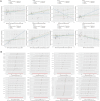Multi-Omics Analyses Reveal Relationships Between Gut Microbiota and Frailty
- PMID: 40620024
- PMCID: PMC12230348
- DOI: 10.1002/brb3.70657
Multi-Omics Analyses Reveal Relationships Between Gut Microbiota and Frailty
Abstract
Introduction: Observational studies suggest a strong association between gut microbiota and frailty, but the underlying mechanisms remain unclear. This study aimed to investigate potential causal links and biological pathways linking gut microbiota and frailty.
Methods: We utilized summary-level data of gut microbiota and frailty data from MiBioGen and a genome-wide association meta-analysis. A bidirectional, two-sample Mendelian randomization (MR) analysis was performed to investigate the causal relationship between gut microbiota and frailty. Additional genetic and genomic analyses were conducted to identify common biological pathways.
Results: We identified eight causal relationships between the gut microbiota composition and frailty. Inverse-variance weighting suggested that genetic liability for the class Betaproteobacteria and genera Allisonella, Bifidobacterium, Clostridium innocuum, and Eubacterium coprostanoligenes was associated with increased frailty risk. In contrast, the class Bacteroidia, genus Eubacterium ruminantium, and the order Bacteroidales were associated with decreased risk. Reverse MR analysis provided no evidence for a causal effect of frailty on gut microbiota composition. In addition, TET2 was identified as a key hub gene associated with frailty, potentially linking gut microbiota to immune dysregulation and aging-related inflammatory pathways.
Conclusions: Our findings provide genetic evidence that gut microbiota composition influences frailty risk and highlight TET2 as a potential mechanistic link via immune dysregulation. These results suggest that microbiota-targeted interventions may offer novel strategies for the prevention and management of frailty in older adults.
Keywords: Mendelian randomization; TET2; frailty; gut microbiota.
© 2025 The Author(s). Brain and Behavior published by Wiley Periodicals LLC.
Conflict of interest statement
The authors declare no conflicts of interest.
Figures







References
-
- Almeida, H. M. , Sardeli A. V., Conway J., Duggal N. A., and Cavaglieri C. R.. 2022. “Comparison Between Frail and Non‐Frail Older Adults' Gut Microbiota: A Systematic Review and Meta‐Analysis.” Ageing Research Reviews 82: 101773. - PubMed
-
- Ansari, I. , Raddatz G., Gutekunst J., et al. 2020. “The Microbiota Programs DNA Methylation to Control Intestinal Homeostasis and Inflammation.” Nature Microbiology 5: 610–619. - PubMed
Publication types
MeSH terms
Grants and funding
LinkOut - more resources
Full Text Sources

